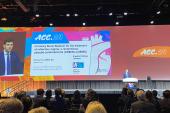Coronary Sinus Reducer Overlooked in Review of Stable Angina Treatments
The device was not included as a potential treatment despite sham-controlled evidence showing it reduces patient symptoms.

A recent state-of-the-art review overlooks a “safe and effective” therapy for patients with stable angina and no good treatment options, according to several cardiologists.
The coronary sinus reducer (CSR) was not mentioned amongst other available therapies, such as coronary revascularization, optimal medical therapy, and lifestyle interventions, for the treatment of select patients with stable angina, say Shmuel Banai, MD (Tel Aviv Medical Center, Israel), and colleagues in a letter published recently in the Journal of the American College of Cardiology.
“The only available effective therapy for patients suffering from severe disabling angina with evidence of reversible myocardial ischemia, despite maximally tolerable medical therapy and no option for revascularization, is the coronary sinus reducer,” Banai told TCTMD in an email.
Until a few years ago, he said, these patients were deemed to have no therapeutic options. Today, coronary sinus constriction with the implantable device has been shown to be safe and effective for patients experiencing refractory angina and obstructive coronary artery disease in two randomized sham-controlled trials (COSIRA and ORBITA-COSMIC), meta-analyses, and multiple real-life registries, said Banai.
In ORBITA-COSMIC, for example, the implantable, hourglass-shaped CSR significantly reduced symptoms at 6 months compared with a sham procedure in just over 100 patients with refractory angina. Another randomized trial, also sham-controlled, is currently ongoing in the US and Canada. For patients with “debilitating angina and obstructive CAD refractory to optimal medical and revascularization strategies,” the European Society of Cardiology (ESC) recommends consideration of a reducer device for coronary sinus restriction to improve symptoms (class IIb, level of evidence A).
Despite the data and guidelines, the review, which was pulled together by the Interventional Cardiology Working Group of the Italian Society of Cardiology, doesn’t mention CSR as a possible treatment.
Review authors Rocco Montone, MD, PhD (Catholic University of the Sacred Heart, Rome, Italy), and colleagues acknowledge the potential of CSR in this patient population, but ultimately do not include it. They focus instead on diagnostic and therapeutic strategies for stable angina that are widely established and commercially available (CSR is not yet approved in the United States). Additionally, use of specialized therapies for refractory angina was beyond the scope of their review, they say
Last year, ORBITA-COSMIC investigators Michael J. Foley, MBBS, and Rasha Al-Lamee, MBBS, PhD (both from Imperial College London, England), published a small survey showing that if a treatment’s mechanism intuitively makes sense to physicians, they are more likely to believe it will be effective. On the flip side, therapies with less obvious mechanisms were much less likely to be considered effective, even those with randomized, controlled data backing them up.
At the time, Foley noted that while a CSR device had been shown to reduce angina episodes in a dedicated study, it “doesn’t fit into a preexisting paradigm for how the disease works.” At present, the precise mechanism of CSR’s beneficial action is unknown, although researchers suspect it is related to improved reperfusion from the epicardium to endocardium.
Michael O’Riordan is the Managing Editor for TCTMD. He completed his undergraduate degrees at Queen’s University in Kingston, ON, and…
Read Full BioSources
Banai S, Lerman A, Verheye S. The reducer is a novel, safe, and effective therapy to optimize the management of patients with stable angina. J Am Coll Cardiol. 2024;Epub ahead of print.
Disclosures
- Banai reports consulting for Shockwave Medical.





Comments